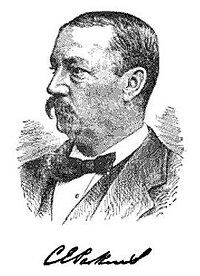Charles Elliott Perkins
| Charles Elliott Perkins | |
|---|---|
 |
|
| Born |
November 24, 1840 Cincinnati, Ohio, U.S. |
| Died | November 8, 1907 (aged 66) Westwood, Massachusetts, U.S. |
| Nationality | American |
| Occupation | Railroad executive |
| Known for | President, Chicago, Burlington and Quincy Railroad |
Charles Elliott Perkins (November 24, 1840 — November 8, 1907) was an American businessman and president of the Chicago, Burlington and Quincy Railroad. He was so well respected that historian Richard Overton wrote, "From the time that Charles Elliott Perkins became vice president of the Chicago, Burlington and Quincy [1876] ... until he resigned as president in 1901, he was the Burlington."
He was born in Cincinnati, Ohio, on November 24, 1840, to James Handasyd and Sarah Hart (Elliott) Perkins. His ancestor was Pierre de Morlaix, bailiff at Malvern Chase (the large forest which was the favorite hunting ground of Edward I of England). His ancestor Edmund Perkins emigrated to Boston, Massachusetts, some time before 1677. His father, James Handasyd Perkins, was a noted Unitarian minister in Cincinnati. Charles was the oldest of five boys. He drowned (it may have been suicide) when Perkins was a child.
Charles Perkins was educated in the Cincinnati public schools, graduating from high school at the age of 16. He also received a portion of his education from Milton Academy in Milton, Massachusetts.
When he was 16 years old, he moved to Burlington, Iowa, where he won a job as a clerk in a fruit store. When he was 19 he took a job as a clerk for the Burlington and Missouri River Railroad (B&MR). He was promoted to paymaster a year later, and then at age 20 was made Assistant Treasurer of the railroad in 1860. His rapid rise in the company's ranks was not surprising: His uncle was John Murray Forbes, the railroad's president. He was named Acting Superintendent and then Superintendent of the line in 1865. At that time, the railroad extended a mere 75 miles (121 km), from Burlington to Ottumwa, Iowa.
He helped incorporate the Burlington and Missouri River's Nebraska division, and was named its director as well as director of the line's Iowa division. Perkins was appointed vice president of the Burlington and Missouri River Railroad in 1872. He was also named president of the B&MR's Nebraska division (a position he held until 1875). On January 1, 1873, the railroad merged with the Chicago, Burlington and Quincy (CB&Q), but he continued to hold the position of president of the Nebraska division. This proved a difficult economic time for the railroad. The Panic of 1873 set off the Long Depression, a prolonged period of deflation and little economic growth which did not end until after the Panic of 1893. During the first several years of the Long Depression, the CB&Q neither acquired nor built any new track, although the parent railroad did absorb its Iowa division.
...
Wikipedia
